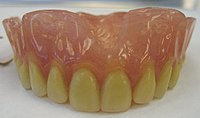
Photo from wikipedia
Abstract Objectives This study aimed to evaluate the influence of different salivary pH on flexural strength, hardness, and surface roughness of computer-aided design and computer-aided manufacturing (CAD/CAM) milled and three-dimensional… Click to show full abstract
Abstract Objectives This study aimed to evaluate the influence of different salivary pH on flexural strength, hardness, and surface roughness of computer-aided design and computer-aided manufacturing (CAD/CAM) milled and three-dimensional (3D)-printed denture base resins. Methods One heat-polymerized, two CAD/CAM milled (IvoCad, AvaDent), and two 3D-printed (FormLabs, NextDent) denture base resins were fabricated and divided into five groups ( n = 10) according to the solutions: three groups were immersed in different salivary pH (5.7, 7.0, or 8.3), one group was immersed in distilled water (DW) as a positive control, and one group had no immersion (negative control). All immersions were performed at 37°C for 90 days. Flexural strength, hardness, and surface roughness were measured before and after immersion. Data was analyzed with analysis of variance and post hoc Tukey's test ( α = 0.05). Results After immersion, all specimens had lower flexural strength values when compared with those with no immersion. Comparing the immersion groups, the highest flexural strength value (93.96 ± 3.18 MPa) was recorded with IvoCad after immersion in DW while the lowest value (60.43 ± 2.66 MPa) was recorded with NextDent after being immersed in 7.0 pH saliva. All specimens had significant decrease in hardness except IvoCad and AvaDent specimens where both presented the highest surface hardness (53.76 ± 1.60 Vickers hardness number [VHN]) after immersion in DW while NextDent showed the lowest hardness value (24.91 ± 2.13 VHN) after being immersed in 8.3 pH saliva. There was statistically significant difference between the baseline and different artificial salivary pH solutions in terms of surfaces roughness, with the highest surface roughness were found in 3D-printed resin materials. Conclusion After exposure to artificial saliva with different salivary pH, the milled CAD/CAM denture base resins showed higher flexural strength, hardness, and lesser surface roughness than conventional and 3D-printed denture base resins.
Journal Title: European Journal of Dentistry
Year Published: 2022
Link to full text (if available)
Share on Social Media: Sign Up to like & get
recommendations!